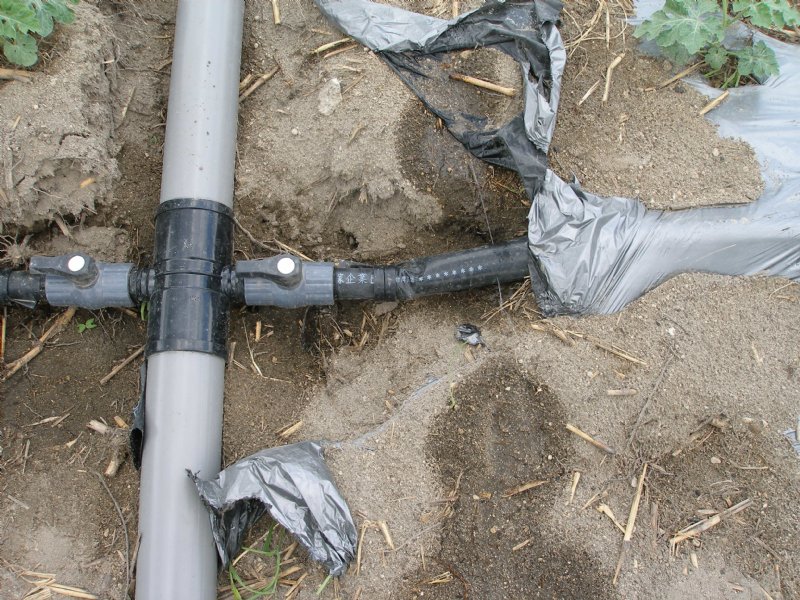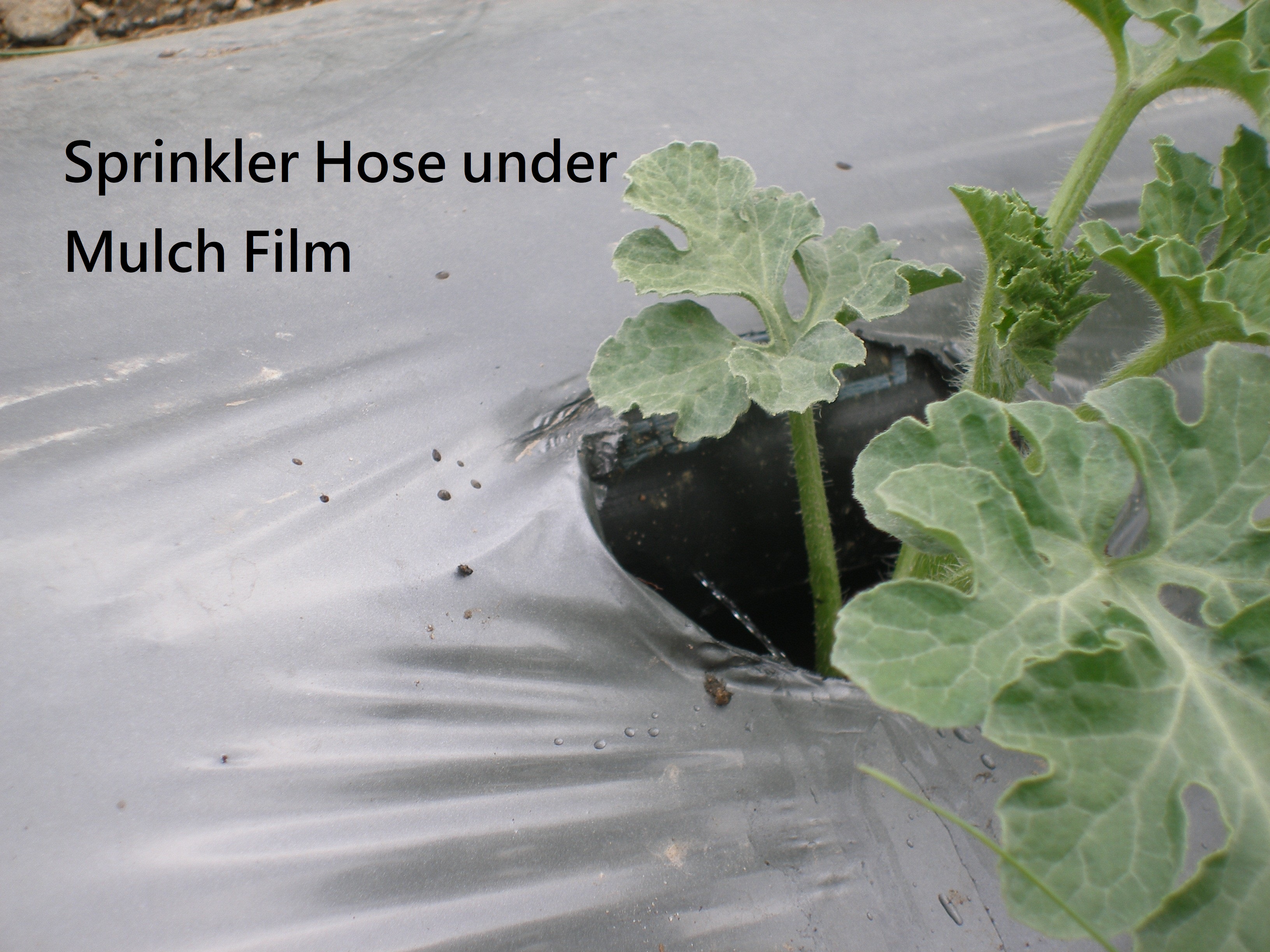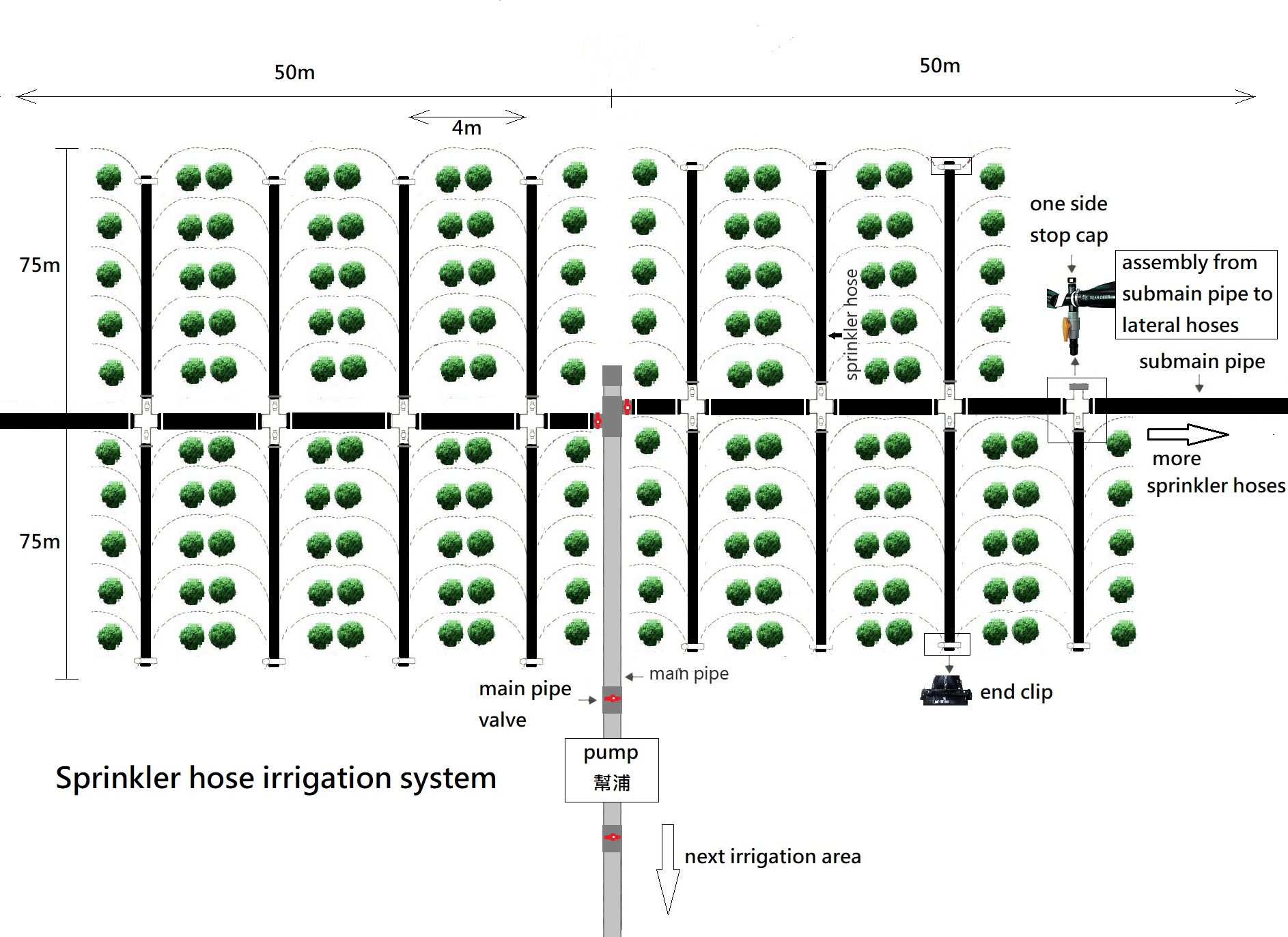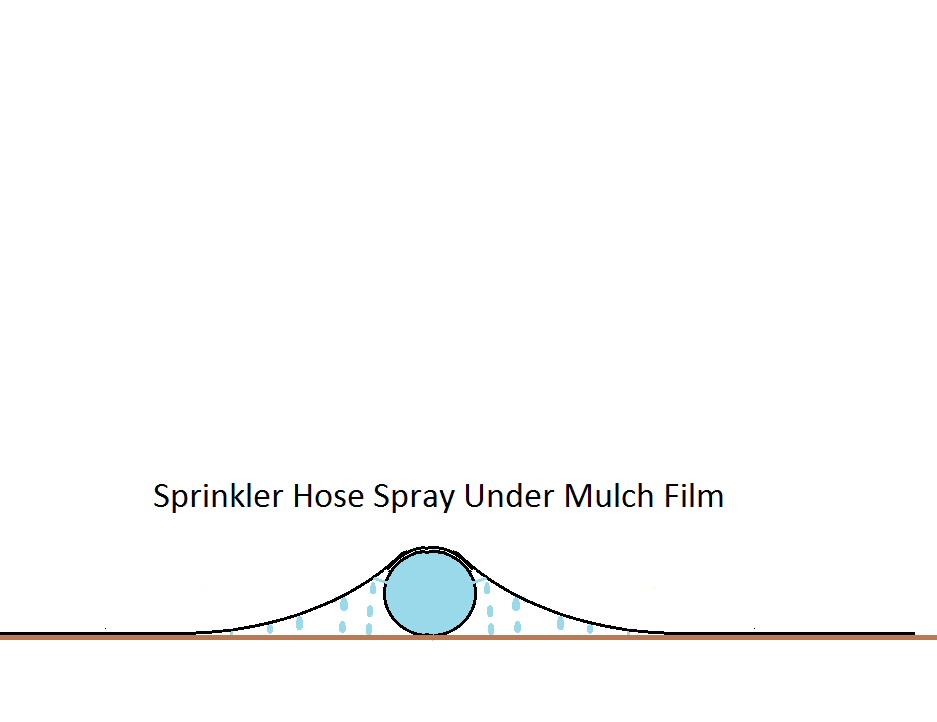
Home > Products > Irrigation Sprinkler Hose, AJ series, rain pipe, rain tape, micro spray tube, Farm Irrigation Hose > Irrigation Sprinkler Hose, AJ-100 series, sprinkler tape, lay flat tube, rain tape, rain pipe, rain hose, micro spray tube, micro spray hose, soaker hose, farm irrigation hose, kansui tube, selang irigasi
Irrigation Sprinkler Hose, AJ-100 series, sprinkler tape, lay flat tube, rain tape, rain pipe, rain hose, micro spray tube, micro spray hose, soaker hose, farm irrigation hose, kansui tube, selang irigasi





Improveming Shallow-rooted Plants Drip Irrigation Efficiency with Sprinkler Hose Under Mulch Film
Features
Maximización de la eficiencia del riego de cultivos con manguera de aspersión debajo de una película de mantillo
En el mundo de la agricultura, las técnicas de riego eficientes son cruciales para garantizar un crecimiento óptimo de los cultivos y maximizar los rendimientos. Uno de esos métodos innovadores que ha ganado importancia en los últimos años es el uso de mangueras de aspersión debajo de una película de mantillo. Este enfoque de riego no sólo conserva el agua sino que también ofrece una multitud de beneficios para la salud de los cultivos y el rendimiento general. Aquí exploramos las ventajas y las instrucciones paso a paso para implementar este eficiente sistema de riego.
El desafío de la eficiencia
La mayoría de los cultivos, especialmente las plantas de raíces poco profundas, a menudo enfrentan desafíos cuando se trata del riego por goteo tradicional. Los sistemas de riego por goteo penetran verticalmente en el suelo y el agua tiende a filtrarse demasiado profundo para que las raíces poco profundas la absorban de manera eficiente. Esto da como resultado un desperdicio de recursos hídricos, ya que las raíces no pueden acceder a la humedad de manera efectiva. Para superar este desafío, los sistemas tradicionales de riego por goteo emplean múltiples ráfagas cortas de riego intermitente, lo que puede llevar mucho tiempo y mano de obra.
La solución: manguera de aspersor debajo de una película de mantillo
La manguera de aspersión bajo película de mantillo presenta una alternativa más simple y efectiva al riego por goteo tradicional. Este innovador sistema difunde el agua sobre un área más amplia en menos tiempo, lo que permite que los cultivos absorban la humedad de manera eficiente. En comparación con el riego por goteo, demuestra ser un método sencillo, que ahorra tiempo y requiere mucha mano de obra. Además, aborda las necesidades específicas de las plantas de raíces poco profundas.
Proceso de instalación
Implementar una manguera de rociadores bajo un sistema de película de mantillo es relativamente sencillo. Aquí hay una guía paso a paso para hacerlo bien:
Coloque la manguera del rociador: comience colocando la manguera del rociador a lo largo de las hileras programadas para plantar o que ya se habían plantado. Esta colocación de la manguera garantiza que el agua llegue a las raíces de forma eficaz.
Aplique la película de mantillo: luego, coloque la cubierta de mantillo sobre la manguera del aspersor. Este proceso combinado se puede completar de manera eficiente utilizando herramientas especializadas diseñadas para colocar la manguera del rociador y la película de mantillo al mismo tiempo.
Deje que salgan las plantas: Las plantas deben emerger de los agujeros que se han perforado en la película de mantillo. Esto les permite no estar cubiertos por una película de mantillo.
Integración de fertirrigación: para obtener resultados óptimos, considere integrar un sistema de fertirrigación en la cabecera del sistema de riego. Esta adición permite la entrega simultánea de fertilizantes líquidos o pesticidas directamente a las raíces de las plantas junto con el agua de riego.
Beneficios de la manguera para rociadores debajo de la película mantillo
Ahora que hemos cubierto el proceso de instalación, profundicemos en las ventajas de utilizar este innovador método de riego:
1. Reducción de la Lixiviación de Fertilizantes
Los métodos tradicionales de riego por inundación y por surcos tienden a lixiviar los fertilizantes, incluido el valioso nitrógeno y otros nutrientes, profundamente en el suelo, fuera del alcance de las raíces de las plantas. La manguera de aspersión debajo de la película de mantillo, en combinación con la película de mantillo de plástico, reduce significativamente este efecto de lixiviación. Proporciona menores cantidades de agua y fertilizantes directamente a la zona de las raíces, lo que reduce la cantidad de fertilizante necesaria para un crecimiento óptimo de las plantas.
2. Hacer que la hierba sea más manejable
La película de plástico para mantillo, que a menudo se usa junto con una manguera de rociador debajo de la película de mantillo, crea un ambiente que inhibe el crecimiento de malezas. Al evitar que la luz del sol llegue al suelo, estas películas de mantillo reducen eficazmente la competencia de las malas hierbas. Cualquier crecimiento de malezas tiende a limitarse a los agujeros en el mantillo donde emergen las plantas, lo que hace que el manejo de malezas sea más manejable.
3. Garantizar niveles constantes de humedad del suelo
Las películas de plástico para mantillo no sólo eliminan las malas hierbas sino que también reducen la pérdida de agua por evaporación. Esto significa que se requiere menos agua para el riego, lo que lo convierte en una opción sostenible. Además, las películas plásticas de mantillo ayudan a las mangueras de los aspersores a distribuir la humedad de manera uniforme en el suelo, lo que reduce el estrés de las plantas y garantiza niveles constant.
En el mundo de la agricultura, las técnicas de riego eficientes son cruciales para garantizar un crecimiento óptimo de los cultivos y maximizar los rendimientos. Uno de esos métodos innovadores que ha ganado importancia en los últimos años es el uso de mangueras de aspersión debajo de una película de mantillo. Este enfoque de riego no sólo conserva el agua sino que también ofrece una multitud de beneficios para la salud de los cultivos y el rendimiento general. Aquí exploramos las ventajas y las instrucciones paso a paso para implementar este eficiente sistema de riego.
El desafío de la eficiencia
La mayoría de los cultivos, especialmente las plantas de raíces poco profundas, a menudo enfrentan desafíos cuando se trata del riego por goteo tradicional. Los sistemas de riego por goteo penetran verticalmente en el suelo y el agua tiende a filtrarse demasiado profundo para que las raíces poco profundas la absorban de manera eficiente. Esto da como resultado un desperdicio de recursos hídricos, ya que las raíces no pueden acceder a la humedad de manera efectiva. Para superar este desafío, los sistemas tradicionales de riego por goteo emplean múltiples ráfagas cortas de riego intermitente, lo que puede llevar mucho tiempo y mano de obra.
La solución: manguera de aspersor debajo de una película de mantillo
La manguera de aspersión bajo película de mantillo presenta una alternativa más simple y efectiva al riego por goteo tradicional. Este innovador sistema difunde el agua sobre un área más amplia en menos tiempo, lo que permite que los cultivos absorban la humedad de manera eficiente. En comparación con el riego por goteo, demuestra ser un método sencillo, que ahorra tiempo y requiere mucha mano de obra. Además, aborda las necesidades específicas de las plantas de raíces poco profundas.
Proceso de instalación
Implementar una manguera de rociadores bajo un sistema de película de mantillo es relativamente sencillo. Aquí hay una guía paso a paso para hacerlo bien:
Coloque la manguera del rociador: comience colocando la manguera del rociador a lo largo de las hileras programadas para plantar o que ya se habían plantado. Esta colocación de la manguera garantiza que el agua llegue a las raíces de forma eficaz.
Aplique la película de mantillo: luego, coloque la cubierta de mantillo sobre la manguera del aspersor. Este proceso combinado se puede completar de manera eficiente utilizando herramientas especializadas diseñadas para colocar la manguera del rociador y la película de mantillo al mismo tiempo.
Deje que salgan las plantas: Las plantas deben emerger de los agujeros que se han perforado en la película de mantillo. Esto les permite no estar cubiertos por una película de mantillo.
Integración de fertirrigación: para obtener resultados óptimos, considere integrar un sistema de fertirrigación en la cabecera del sistema de riego. Esta adición permite la entrega simultánea de fertilizantes líquidos o pesticidas directamente a las raíces de las plantas junto con el agua de riego.
Beneficios de la manguera para rociadores debajo de la película mantillo
Ahora que hemos cubierto el proceso de instalación, profundicemos en las ventajas de utilizar este innovador método de riego:
1. Reducción de la Lixiviación de Fertilizantes
Los métodos tradicionales de riego por inundación y por surcos tienden a lixiviar los fertilizantes, incluido el valioso nitrógeno y otros nutrientes, profundamente en el suelo, fuera del alcance de las raíces de las plantas. La manguera de aspersión debajo de la película de mantillo, en combinación con la película de mantillo de plástico, reduce significativamente este efecto de lixiviación. Proporciona menores cantidades de agua y fertilizantes directamente a la zona de las raíces, lo que reduce la cantidad de fertilizante necesaria para un crecimiento óptimo de las plantas.
2. Hacer que la hierba sea más manejable
La película de plástico para mantillo, que a menudo se usa junto con una manguera de rociador debajo de la película de mantillo, crea un ambiente que inhibe el crecimiento de malezas. Al evitar que la luz del sol llegue al suelo, estas películas de mantillo reducen eficazmente la competencia de las malas hierbas. Cualquier crecimiento de malezas tiende a limitarse a los agujeros en el mantillo donde emergen las plantas, lo que hace que el manejo de malezas sea más manejable.
3. Garantizar niveles constantes de humedad del suelo
Las películas de plástico para mantillo no sólo eliminan las malas hierbas sino que también reducen la pérdida de agua por evaporación. Esto significa que se requiere menos agua para el riego, lo que lo convierte en una opción sostenible. Además, las películas plásticas de mantillo ayudan a las mangueras de los aspersores a distribuir la humedad de manera uniforme en el suelo, lo que reduce el estrés de las plantas y garantiza niveles constant.
Safety/Quality Approvals
ISO 9001:2015














